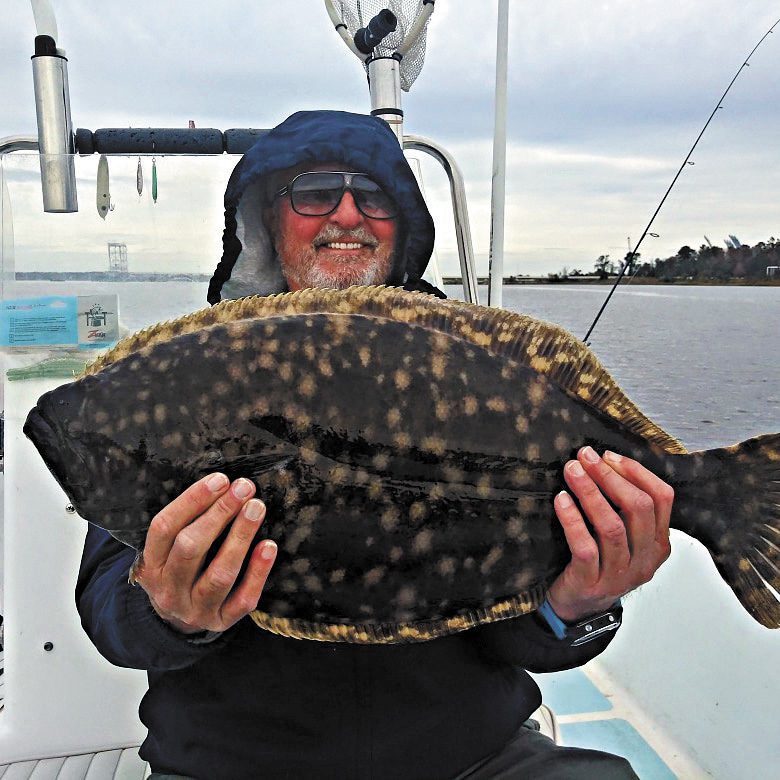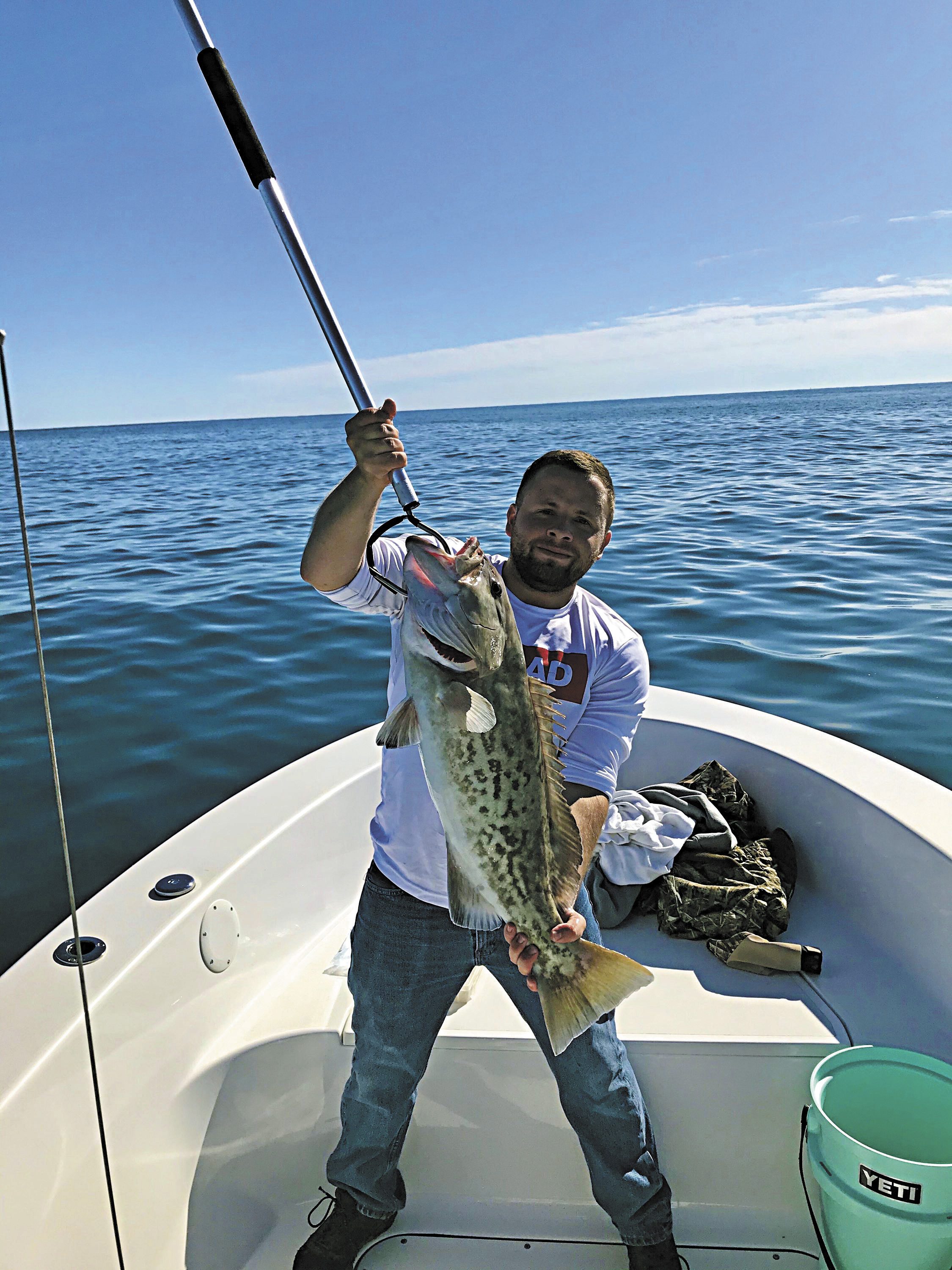Wrightsville Beach – Winter 2019-2020
Matt, of Tex’s Tackle, reports with water temperatures dipping into the mid-50s, fishing inshore has started to take on much more of a winter-like pattern. Schools of undersize to mid-slot red and black drum have started to school up back in the marshes and creeks. The fish will spend some time on open flats, especially on the warm sunny days, but will also hang around docks and oyster bars, especially around low tide.
Most of the upper- to over-slot drum are coming from the surf zone, and they will typically spend most of the winter out in the ocean.
Speckled trout fishing has remained excellent, but there’s started to be an abundance of undersized fish mixed in with the keepers. The bigger fish are being caught in the creeks, near the inlets, and in the surf. The water around Wrightsville Beach has really started to clear up, so fluorocarbon leaders and a natural presentation have been keys to success.
From the surf, Virginia mullet and pufferfish are being caught in strong numbers, along with some good-sized speckled trout, black drum, pompano, and red drum. The surf fishing last winter stayed consistent all the way into the spring for everything, except the pompano.
Anglers fishing nearshore structure have been doing well with gray trout, and it won’t be long before some sheepshead, tautog, and black sea bass start to stack up on the same structures.
There haven’t been many king mackerel reports lately, but typically this time of year the best action is going to be found 25+ miles out, and the king mackerel bite out around Frying Pan Tower should stay consistent throughout the winter.
The bottom fishing out in the 15-30 mile range has been great for gag grouper, sea bass, beeliners, and grunts.
There’s been a few bluefin tuna sightings off Wrighsville, but none have been caught off of our beaches (at the time of this report). The bluefins will show up, but it’s here one day and gone the next. They can be targeted by trolling horse ballyhoo. Bait, birds, whales, etc. are all good signs that you’re in the right location.
Gulf Stream action has been pretty strong. Most of the boats putting the time into trolling have been getting shots at sailfish, wahoo, blackfin tuna, and even a few nice mahi. Different spreads will produce different results. Hopefully, this winter will bring in some more of the world-class wahoo fishing that we saw last year in January and February.
In addition, bottom fishing and jigging has been consistently producing grouper, amberjack, blackfins, beeliners, triggerfish, and other snappers. This should continue throughout the winter.

Mike Bernstein, of Wilmington, NC, with a 9 lb. flounder caught (and released) in the Cape Fear River. He was fishing with Capt. Jamie Rushing of Seagate Charters.
Arlen, of Intracoastal Angler, reports that speckled trout fishing continues to be strong, especially around the inlets. Anglers fishing the Masonboro jetties and Carolina Beach Inlet with live shrimp and full-sized MirrOlures have been reporting fish up to 6 lbs.
In the waterway and creeks, trout are plentiful; however, many are small. A few larger fish are coming from deeper boat basins and coves, where smaller soft plastics fished very slow will do the trick.
Mixed catches of trout and stripers are being reported in the Cape Fear River, mainly along downtown stretches and in the Brunswick, with swimshads and larger paddletails the best choices.
As the water temps continue to drop, look for good numbers of black drum, tautog, and sheepshead to congregate around the Masonboro jetties and nearshore reefs, where live shrimp and cut crabs on First Flight jigs will produce the best results.
Surf fishing is seeing catches of whiting, red drum, and speckled trout. Fresh shrimp and cut mullet are the baits of choice, with swimbaits and MirrOlures accounting for the trout.
Bottom fishing has been decent for gag grouper and black sea bass in the 20 mile range, with cigar minnows and squid strips producing the best. Anglers trolling cigar minnows and Drone spoons in the 35-40 mile range have seen very steady king mackerel action. Look for this bite to continue into the winter, where finding 68 degree water (areas around Frying Pan Tower) will help you locate the kings.
Gulf Stream fishing has been hit or miss, with most catches comprised of blackfin tuna and sailfish. A few wahoo have been reported, with some up to 80 lbs. As with the past few years, look for the wahoo fishing to improve throughout January and February, where Ilander/ballyhoo combos, as well as high speed lures, will produce the best.
Blackfin tuna will also stick around throughout the winter, mainly around the Nipple and Steeples. Smaller trolling lures and green machines (as well as vertical jigs) are the best choices when targeting the blackfins.
Jamie, of Seagate Charters, reports that trout fishing remains solid. The larger fish seem to be around the inlets, and the fish will readily take interest in artificial baits from D.O.A., MirrOlure, Z-Man, and Blue Water Candy classic combinations. Live bait has been getting the most bites, though.
Red and black drum have started to school up on area ICW docks. A good way to get around all the pinfish is using frozen or fresh shrimp.
Cape Fear River fishing has been good with striped bass, redfish, speckled trout, and flounder.

Shawn Laskowski with a 12.6 lb. gag grouper caught 23 miles off of Wrightville Beach on a cut squid.
Trevor, of ProFishNC Charters, reports that trout have been on fire and will continue to be thick through early January. Inshore fishing in general will stay consistent throughout the winter, especially when using natural dead bait around deep water docks on warmer days.
The tautog bite that is just starting to take off will remain strong through March. Fish nearshore wrecks, rocky bottoms, and ledges with crabs or shrimp for the best results. Also, black sea bass will be feeding all winter from the jetty out to 5 miles.
Rick, of Living Waters Guide Service, reports that kings and false albacore are schooling and slowly moving offshore, where they can be found at 15 miles and further. The wahoo and sailfish have been slow, but blackfin tuna in the 30 lb. range are tearing up any bait being trolled, jigged, or popped.
Now is the time, though, to look for a bluefin tuna marauding bait on the beach, which they will continue to do throughout the winter.
Bottom fishing is still consistent for gags and scamps from depths of 80-100’. The assorted grunts, beeliners, pinkies, and sea bass are being picked up as well.
This winter, expect cooler water to push offshore and bring African pompano and other species to the break where you’ll be able to jig them. Also, trolling will be good for wahoo and blackfins around structure on the break.
Bottom fishing will produce grunts and sea bass in 75-100’ of water, with squid and metal jigs likely to bring in the most fish.
Gabe, of Johnnie Mercer’s Pier, reports that there’s been strong catches of trout in the early mornings and dusk on fresh shrimp and Gotcha plugs. Small black drum are biting fresh shrimp, bluefish are still coming over the rails on plugs, and there has also been a few in-slot red drum. In addition, a handful of pompano and whiting are being caught on shrimp and sand fleas.
Through the winter, the bite will stay strong as long as the water hangs in the low 60 degree range. If the water does drop a few more degrees, expect a stronger trout presence, but don’t be surprised to still find flounder, good-sized mullet, and the occasional drum. Also expect an occasional dogfish.
